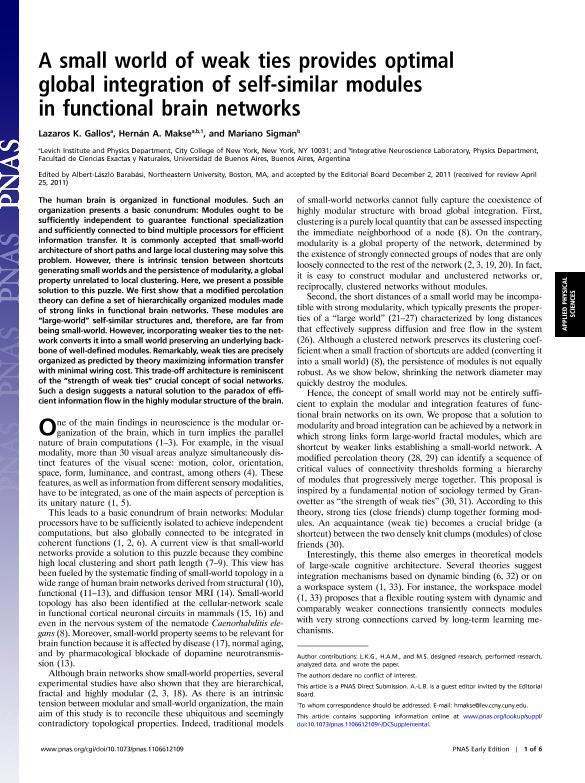Mostrar el registro sencillo del ítem
dc.contributor.author
Gallos, Lazaros K.
dc.contributor.author
Makse, Hernán Alejandro

dc.contributor.author
Sigman, Mariano

dc.date.available
2019-06-13T16:18:45Z
dc.date.issued
2012-02
dc.identifier.citation
Gallos, Lazaros K.; Makse, Hernán Alejandro; Sigman, Mariano; A small world of weak ties provides optimal global integration of self-similar modules in functional brain networks; National Academy of Sciences; Proceedings of the National Academy of Sciences of The United States of America; 109; 8; 2-2012; 2825-2830
dc.identifier.issn
0027-8424
dc.identifier.uri
http://hdl.handle.net/11336/78215
dc.description.abstract
The human brain is organized in functional modules. Such an organization presents a basic conundrum: Modules ought to be sufficiently independent to guarantee functional specialization and sufficiently connected to bind multiple processors for efficient information transfer. It is commonly accepted that small-world architecture of short paths and large local clustering may solve this problem. However, there is intrinsic tension between shortcuts generating small worlds and the persistence of modularity, a global property unrelated to local clustering. Here, we present a possible solution to this puzzle. We first show that a modified percolation theory can define a set of hierarchically organized modules made of strong links in functional brain networks. These modules are "large-world" self-similar structures and, therefore, are far from being small-world. However, incorporating weaker ties to the network converts it into a small world preserving an underlying backbone of well-defined modules. Remarkably, weak ties are precisely organized as predicted by theory maximizing information transfer with minimal wiring cost. This trade-off architecture is reminiscent of the "strength of weak ties" crucial concept of social networks. Such a design suggests a natural solution to the paradox of efficient information flow in the highly modular structure of the brain.
dc.format
application/pdf
dc.language.iso
eng
dc.publisher
National Academy of Sciences

dc.rights
info:eu-repo/semantics/openAccess
dc.rights
Atribución-NoComercial-CompartirIgual 2.5 Argentina (CC BY-NC-SA 2.5 AR)
dc.rights.uri
https://creativecommons.org/licenses/by-nc-sa/2.5/ar/
dc.subject
No
dc.subject.classification
Astronomía

dc.subject.classification
Ciencias Físicas

dc.subject.classification
CIENCIAS NATURALES Y EXACTAS

dc.title
A small world of weak ties provides optimal global integration of self-similar modules in functional brain networks
dc.type
info:eu-repo/semantics/article
dc.type
info:ar-repo/semantics/artículo
dc.type
info:eu-repo/semantics/publishedVersion
dc.date.updated
2019-06-04T20:18:51Z
dc.journal.volume
109
dc.journal.number
8
dc.journal.pagination
2825-2830
dc.journal.pais
Estados Unidos

dc.journal.ciudad
Washington DC, USA
dc.description.fil
Fil: Gallos, Lazaros K.. City College Of New York; Estados Unidos
dc.description.fil
Fil: Makse, Hernán Alejandro. Universidad de Buenos Aires; Argentina
dc.description.fil
Fil: Sigman, Mariano. Consejo Nacional de Investigaciones Científicas y Técnicas. Oficina de Coordinación Administrativa Ciudad Universitaria. Instituto de Física de Buenos Aires. Universidad de Buenos Aires. Facultad de Ciencias Exactas y Naturales. Instituto de Física de Buenos Aires; Argentina
dc.journal.title
Proceedings of the National Academy of Sciences of The United States of America

dc.relation.alternativeid
info:eu-repo/semantics/altIdentifier/doi/http://dx.doi.org/10.1073/pnas.1106612109
Archivos asociados
